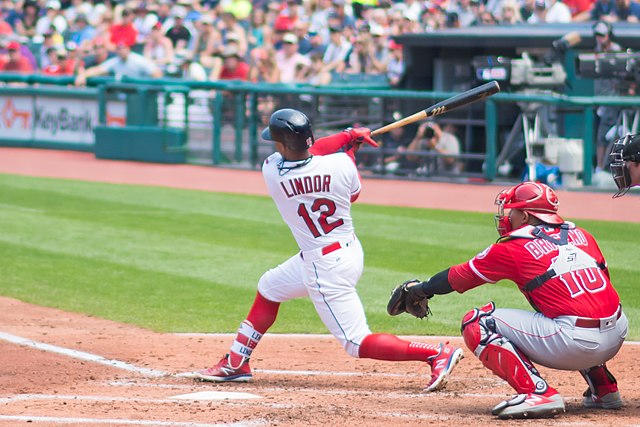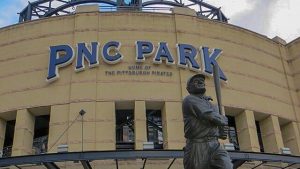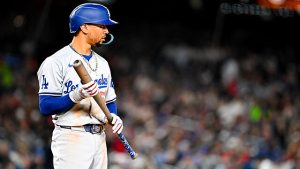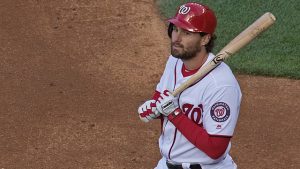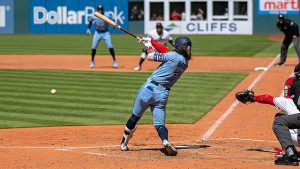Last Updated on June 16, 2024 by Matt Musico
If you’ve ever wondered which hitters are the Guardians single season HR leaders at each position, then you’re in the right place. Outside of pitcher, each player had to qualify for the batting title. Each player also had to man their position for at least 100 games for the season in question.
After you’re done checking this out, head on over to the Guardians’ all-time and single-season home run leaderboards.
Want to see the Guardians slug dingers in person? Grab tickets from our friends at Vivid Seats. And before you get to the stadium, make sure you’re decked out in the right gear. Get official Guardians merch from the MLB Shop or a ‘Big Dinger Energy’ shirt from our apparel store.
Guardians Single Season HR Leaders
Catcher: Victor Martinez (2007) & John Romano (1962): 25 Home Runs
Carlos Santana slugged 27 home runs in 2011, and in many places, you may see his name here. But he only appeared at catcher for 95 games, so he just missed the cut.
The 2007 campaign was Victor Martinez‘s fourth full big-league season in Cleveland. It was also the third time he collected 20-plus homers, all while slashing .302/.376/.484. V-Mart finished seventh in American League MVP voting and his 114 RBI are a single-season career-high mark. He also enjoyed starting fast. Martinez slugged six dingers in the first inning. It was the only frame he hit more than three that season.
John Romano was selected to four All-Star Games between 1961 and 1962. The 25 homers he hit in ’62 were a career-high mark, as were the 81 RBI. In fact, these two years were the only ones of his MLB career where he collected 20-plus dingers and 80-plus RBI at the same time.
What I find interesting is that Romano didn’t hit a single dinger in April (14 games played). But from May through September, he finished a month with fewer than five homers just once (three in August). He hit exactly five in each of June, July, and September, along with slugging seven in May.
Pitcher: Wes Ferrell, 1931: 9 Home Runs
Wes Ferrell has proven to be the ultimate hitting pitcher. His performance stood the test of time, and now, it will stand in perpetuity thanks to the Universal Designated Hitter. He’s not only the career homer leader for pitchers, but he’s also the single-season home run leader for hurlers.
Ferrell posted a 22-12 record and a 3.75 ERA on the mound in 1931. It was the third straight year he reached the 20-win plateau (a streak that would go on for another year before getting snapped). The hurler also entered this year with just one career homer before slugging nine with 30 RBI and a .319/.373/.621 line.
He’d hit at least five homers in a season three other times in his career, but nothing matched 1931, which was his age-23 campaign.
First Base: Jim Thome, 2002: 52 Home Runs
Jim Thome finished his first tour in Cleveland with a bang, that’s for sure. The first baseman hit free agency at the conclusion of the 2002 season. So, all he did from 2001-02 was combine to hit 101 homers (at least 49 in each year) while racking up two straight seventh-place finishes in AL MVP voting.
Those 52 dingers didn’t lead the league, but it’s still the single-season franchise record. Thome didn’t necessarily have one extraordinary month — they pretty much all were. April was the only time he didn’t produce an OPS better than 1.000. However, he never slugged fewer than seven homers in any month and reached double digits three times (10 in June and September, 11 in August).
Despite getting 73 more plate appearances in the first half, his power production before the All-Star break (26 homers, 60 RBI) and after the midsummer classic (26 homers, 58 RBI) was nearly identical.
Second Base: Joe Gordon, 1948: 32 Home Runs
Joe Gordon was home run royalty at the keystone before the game really got modernized. He spent just 11 years in the big leagues (he lost two seasons to serve in World War II) and finished with 253 homers. This included seven seasons of 20-plus dingers, and while he took home MVP honors in 1942, his power production was at its peak in 1948.
Gordon’s 32 homers and 124 RBI were both single-season career-high marks, which helped him finish sixth in MVP voting. He spread his homers out evenly depending on how many outs there were, too. The second baseman slugged 11 with no outs, another 11 with one out, and 10 with two outs.
He also split his homers down the middle when it came to men on base. Of the 32 he hit, 15 were solo shots and 17 had at least one runner on. Of that number, 15 were two-run homers and two were three-run dingers.
Shortstop: Francisco Lindor, 2018: 38 Home Runs
If you want to talk about franchise home run royalty, Francisco Lindor is just that when discussing Cleveland shortstops. His 38 in 2018 is the single-season record, but he also owns each of the top three spots (33 in 2017, 32 in 2019). Oh, and his 26 for the New York Mets is also a franchise record for his position.
The man knows how to hit homers. Those 38 dingers marked the second of three straight seasons with 30-plus for Lindor. He spent the majority of his time in the leadoff spot (153 games), and he was the tone-setter. Eight of his homers came leading off the game, which is a franchise record. In Cleveland’s wins, Lindor slashed .315/.392/.593 with 27 homers, 70 RBI, and 91 runs scored. When they lost, the shortstop slashed .228/.299/.424 with 11 homers, 22 RBI, and 38 runs scored.
He swung at the first pitch in 151 of his plate appearances. Being aggressive early led to solid results, as Lindor posted a .912 OPS with 16 extra-base hits (eight doubles, one triple, and seven homers) in that scenario.
Third Base: Al Rosen, 1953: 42 Home Runs
Al Rosen didn’t get a legit chance to play in the big leagues until 1950, but boy he fit a lot of production in a short period of time. He appeared in 35 total games between 1947 and 1949. Rosen then played at least 121 games in each of his final seven big-league campaigns. He finished with fewer than 20 homers just once (15 in 1956, his last year). Rosen started things off with a bang by setting Cleveland’s rookie home run record, as well.
He led the league in homers twice and RBI twice. Only once did both of those things happen in the same year. Yes, it was 1953. Rosen slugged 42 homers with 145 RBI and a .336/.422/.613 line on his way to winning the MVP award.
The third baseman had two homers and 10 RBI through his first 11 games played (all in April). He never finished with fewer than seven dingers or 20 RBI in any of the remaining five months of the year, though. His best work came in July (nine homers, 30 RBI) and August (nine homers, 37 RBI). In addition to combining for 18 dingers and 67 RBI, Rosen slashed .332/.408/.616 in 482 plate appearances.
Guardians Single Season HR Leaders
Left Field: Albert Belle, 1995: 50 Home Runs
We just talked about Lindor being Cleveland home run royalty for shortstops. That’s what Albert Belle is for left-fielders. He holds each of the top four spots on the positional home run leaderboard. He did it in consecutive seasons, two of which were shortened because of the 1994 Strike (1993-96).
The 1995 season was also his first of three straight top-three finishes in AL MVP voting. This particular year was his best, as he finished second behind Mo Vaughn by only eight points. But still, Belle led the league in homers, doubles (52), runs scored (121), RBI (126), slugging percentage (.690), and total bases (377).
He split his homer production down the middle between home and road games (25 each) but slugged 36 of them after the All-Star break. More specifically, 31 of them came over the final two months. From August 1 through the end of the regular season (257 plate appearances), Belle slugged those 31 homers with 23 doubles, 62 RBI, and 60 runs scored with a .350/.439/.885 line. Unsurprisingly, Cleveland went 41-17 down the stretch.
Center Field: Joe Carter, 1989: 35 Home Runs
Joe Carter is best known for the work he did in the postseason with the Toronto Blue Jays. However, that didn’t come until the second half of his MLB career. Most of the first half of it came in Cleveland. He posted at least 20 homers and 90 RBI in each of his final four years with the club. His last year before skipping town was 1989, and those 35 dingers ended up being a single-season career-high mark for him.
He enjoyed a big second half, as 22 of his homers happened after the All-Star break. Over the season’s first three months, Carter didn’t hit more than six homers, a number he reached once (in June). But over the final three months, he didn’t hit fewer than seven, reaching eight twice (July and August).
What I also found interesting was how Carter spread out his homer production depending on the situation. He slugged 12 when Cleveland was ahead, 12 when they were behind, and another 11 when the game was tied.
Right Field: Manny Ramirez, 1998: 45 Home Runs
Manny Ramirez was already a star by the time 1998 rolled around. He had slugged 30-plus homers in a season twice, but things went into overdrive here. This campaign started a streak of nine straight years with at least 30 homers and 100 RBI. He surpassed the 40-homer plateau five times during this streak, and while it was matched once, Ramirez never hit more than 45 in a year.
Once again, we can see two different stories from the perspective of power when cutting his season into two halves. Through the first three months, Ramirez slugged no more than six homers (which he did twice). But over the final three months, he slugged no fewer than nine. This included 21 from August 1st through the end of the year.
Ramirez spent most of his time as Cleveland’s cleanup hitter, but also hit in the third and fifth spots of the lineup. When he wasn’t producing, they weren’t winning. In victories, he hit .348/.439/.763 with 34 homers and 110 RBI. Those numbers dropped to .228/.296/.396, 11, and 35, respectively, in losses. For those not wanting to do the math at home, that’s a 1.202 OPS in wins and a .692 OPS in losses.
Designated Hitter: Travis Hafner, 2006: 42 Home Runs
Between 2004 and 2007, Travis Hafner was one of baseball’s most feared sluggers. This stretch included four straight years of 20-plus homers and 1oo-plus RBI, two top-10 finishes in AL MVP voting, and a collective triple slash of .296/.410/.567. While his 564 plate appearances in 2006 were the fewest of any year within this stretch, his 42 homers and 117 RBI were both his highest single-season marks.
What’s pretty eye-popping is looking at Hafner’s monthly splits. He slugged exactly seven homers in each of April, May, and June, followed by eight in July and 13 (!) in August. The designated hitter didn’t hit any in September because of a broken hand, limiting him to one game.
Based on the pace he had set for himself, Thome’s club record of 52 homers could’ve very well gone down that year. Hafner also split his homers down the middle depending on the situation. He hit 20 solo homers in 2006, as well as 22 dingers with at least one man on base.
